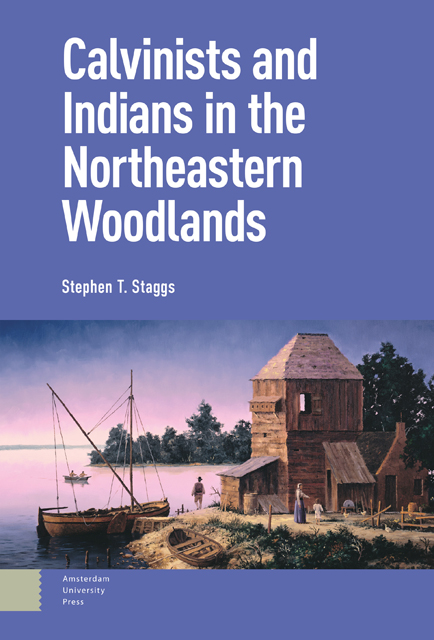Book contents
- Frontmatter
- Contents
- Acknowledgements
- Abbreviations
- List of Figures
- Notes on Usage
- Introduction
- 1 “Gentiles by Nature,” 1566–1626
- 2 “So That the Fullness of the Gentiles Might Gradually Come In,” 1627–1642
- 3 “A Church and Community among the Christians and the Blind Gentiles,” 1642–1652
- 4 “We, with God’s Help, Hope to Bring the Barbarous Tribes to Devotion,” 1652–1660
- 5 “Who Gave Jacob for a Spoil and Israel to the Robbers?” 1660–1664
- 6 “A Gentile Woman, Karanondo, … Now Called Lidia,” 1664–1750
- Conclusion
- Appendix A Dutch References to Indians: 1609–1664
- Appendix B Indian Baptisms, Professions of Faith, and Marriages in the Dutch Reformed Churches of New York: 1690–1750
- List of Archival Sources
- Bibliography
- Index
2 - “So That the Fullness of the Gentiles Might Gradually Come In,” 1627–1642
Published online by Cambridge University Press: 17 October 2023
- Frontmatter
- Contents
- Acknowledgements
- Abbreviations
- List of Figures
- Notes on Usage
- Introduction
- 1 “Gentiles by Nature,” 1566–1626
- 2 “So That the Fullness of the Gentiles Might Gradually Come In,” 1627–1642
- 3 “A Church and Community among the Christians and the Blind Gentiles,” 1642–1652
- 4 “We, with God’s Help, Hope to Bring the Barbarous Tribes to Devotion,” 1652–1660
- 5 “Who Gave Jacob for a Spoil and Israel to the Robbers?” 1660–1664
- 6 “A Gentile Woman, Karanondo, … Now Called Lidia,” 1664–1750
- Conclusion
- Appendix A Dutch References to Indians: 1609–1664
- Appendix B Indian Baptisms, Professions of Faith, and Marriages in the Dutch Reformed Churches of New York: 1690–1750
- List of Archival Sources
- Bibliography
- Index
Summary
Abstract
Chapter two explores the period between 1627 and 1642 when New Netherlanders were struggling to survive in the Northeastern Woodlands. It highlights the sources of inspiration and efforts of the leaders of the West India Company (WIC) and Dutch Reformed Church who instructed the first lay chaplains and clergy to proselytize among Native Americans. Although their efforts drew some into the Reformed Christian fold, Lenape–Dutch relations grew tense. The newest colonial leaders were no longer following the WIC playbook. By not dealing with the Lenape in an honest fashion, the work of drawing them to the Reformed faith would prove even more difficult. The hope of Calvinist leaders in Amsterdam was that a Jesuit-trained pastor might make some inroads.
Keywords: Dutch Republic, Dutch Calvinism, New Netherland, Lenape Indians, Haudenosaunee, Native–Dutch Relations
Sint Pancras, 1627
In 1627 Johannes extended his right hand and clasped the right hand of his uncle's twenty-seven-year-old stepdaughter, Machtelt Willems, before the predikant (preacher) and elders of the Dutch Reformed Church of Sint Pancras. After clasping hands, the predikant—their uncle and stepfather, Dominee (Reverend) Johannes Megapolensis—raised his right hand and blessed the couple. Into this new union Machtelt brought a young son from an earlier marriage. His name was Wilhelmus Grasmeer. A year later Machtelt gave birth to a baby girl who was named after Machtelt's mother, Hillegont. A baby boy, Dirck, followed in 1630. Three years later the family of five moved some sixteen miles north to the village of Wieringerwaard where Johannes became schoolmaster. It was here, in Wieringerwaard, that Johannes delivered his proefpreek (test sermon) for the Reformed Classis of Alkmaar while a candidate of theology. Having passed his exam, the Classis of Alkmaar appointed him the first predikant to Wieringerwaard in 1634, a position he held for the next four years. During that time, Machtelt and Johannes also welcomed two more boys—Johannes (b. 1632) and Samuel (b. 1634)—into the world.
This was a time when the worlds and fields of Dutch Reformed predikanten were expanding across Africa, Asia, and the Americas. In fact, the directors of the Geoctroyeerde West-Indische Compagnie (Chartered West India Company or WIC) had recently presented themselves to Frederik Hendrik, Prince of Orange, as “mostly professors of the true Reformed religion” whose primary motives for investing in the company had been “first, to honor God, second, to extend the true Reformed religion here and spreading it in other lands, third, to care for the welfare of this country, and this city [Amsterdam] in particular, and fourth, to damage the common enemy [the Spanish Hapsburgs].”
- Type
- Chapter
- Information
- Calvinists and Indians in the Northeastern Woodlands , pp. 61 - 92Publisher: Amsterdam University PressPrint publication year: 2023

